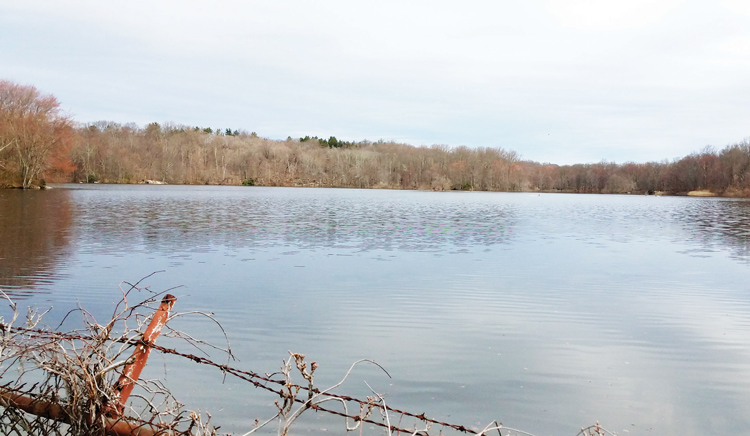

By Paul Silverfarb
Sentinel Editor
Anybody driving up North Street in Greenwich will see something that is making people in town quite pleased.
Just feet away from the Greenwich Fire Department’s North Street station and the ramp from the Merritt Parkway going Southbound is a lake full of water, with trees all around it. Sounds like a typical body of water that people could see anywhere at any time. But six months ago, that lake had dried to the point where one could easily walk from side-to-side and barely get his feet wet.
“For quite a while, we were in an extreme drought throughout Connecticut,” said Gary Lessor, assistant to the director of meteorological studies at Western Connecticut State University. “Because of all the precipitation, we are just now just classified as abnormally dry, except for central Connecticut, which is still under moderate drought conditions. Southwestern Connecticut got a little bit more rain during the fall and early winter than the middle of the state.”
And the inches of rain have been piling up this winter and early spring, and the year-to-date averages are encouraging. Measured at Sikorsky Airport in Stratford, southwestern Connecticut has seen 14.35 inches of precipitation, compared to only 12.04 this time last year. The year-to-date average rainfall should be 14.07, a total the area has already met.
“The numbers are improving,” Lessor said. “I heard that some reservoir levels are at 98 percent, and to me that’s really good for this time of the year. There are other years we are at 100 percent or overflowing throughout the winter. But to be two percent under isn’t really that bad. I still do see some rivers and reservoirs that aren’t quite that high, but overall the numbers have come back dramatically.”
Greenwich Conservation Commission director Denise Savageau couldn’t be happier with the rainfall, but she also knows that the town isn’t out of the woods just yet.
“We have had some much-needed rain and the conditions are really improving,” said Savageau. “We are obviously very happy about that. But we want to remind people that we are still in a deficit for the past year. We had good news with the rain and we will take all the rain we can get right now, but we also want people to understand that you don’t go into a drought in one month and come out it in one month. One of our jobs here is to make sure that we put everything in place so we don’t end up where we were last year and make the same mistakes we made last year.”
With the improved conditions, the town of Greenwich and Aquarion have removed the sprinkler irrigation ban and changed it to a twice-weekly sprinkler irrigation schedule.
“Outdoor watering puts a huge strain on the water supply, accounting regionally for 38 percent of the usage,” said Charles V. Firlotte, Aquarion Water Co.’s president and CEO. “And the EPA estimates that over half of outdoor water use is wasted.”
In Greenwich, residents with addresses ending in even numbers may water only on Sundays and Wednesdays and before 10 a.m. or after 6 p.m. At odd-numbered addresses, watering may only take place on Saturdays and Tuesdays in the same time frame.
“We are very confident that will help,” Savageau said. “In this area, we really don’t need to water lawns more than twice a week. It can get a little hot and humid here in July, but we don’t have the heat like they do in other parts of the country. We should be good. We know that this will be a transition for people. People obviously invest a lot of money into their property and we want to make sure the properties are well-maintained.”
To aid residents in keeping their lawns looking healthy and green, the Conservation Commission already has information available about over-watering, composting, maintaining healthy soil, and the like.
“Basically, the whole concept is that healthy soil is the key to a healthy yard and healthy lawn,” Savageau said. “We are really going to be promoting that and we will be working with different groups in terms of doing outreach and education on how best to have a water-friendly yard. This way people could be water-conscious every day and also have the yards they desire.”
That reservoirs are near or at capacity doesn’t mean everything is back to normal and Greenwich residents have no cause to worry. The reservoirs are looking good right now, but not everything has gotten back to normal.
The Conservation Commission closely monitors the stream levels, and Savageau said that despite the heavy rains that came through Greenwich in the past month, the streams are still below average.
At the end of March and early April, the town got hit with three or four days of rain totaling almost five inches.
“When you have that much rain all at once, you have saturated soil conditions and a lot of runoff,” Savageau said. “So we really didn’t get as much water going into our system as we would have liked. Obviously the reservoirs filled up, as they are set up to capture surface water like that. But when looked at the stream gauges after all that rain, they were still running below average for that time of year.”
Lessor said the more long-term and the more frequent the precipitation happens, the better.
“This is the time of the year that you want to make sure your reservoirs are full so that way when we go into summertime and it typically dries out and the precipitation becomes more showery, you’re better able to withstand the drier periods,” Lessor said. “Being that we are at 98 percent this year, we should have less of an issue than we did last year. The rains have come back and we will have some rains in the upcoming forecasts. We are going into an El Niño pattern, so going longer term, we might see a drought try and reestablish itself.”
El Niño is a warming in the Pacific. It tends to cause extended periods of dry weather or hot weather with either excessive precipitation or less precipitation than normal. However, not all El Niños are the same.
“The last time we ended up with a drought, which is normal,” Lessor said. “There’s a possibility that this sets up where we end up getting drenched. We could end up with flooding, but that’s not typically the scenario that does occur. Typically we get dry and hot weather and go back towards a drought.”
As for the summer, Lessor predicts that Greenwich will start the summer off a little warmer and wetter than usual. After that, Lessor said he expects the summer to be another hot and dry one.
“We are going to transition to the hot and dry once the summer progresses,” Lessor said. “Until this wet pattern that we are in finally comes to a completion, you can’t forecast against it. Once the pattern changes, it should be hot and dry.”
Lessor said that the area is already starting to see the changes in the pattern, although it’s not visible quite yet.
“We are starting to see the heat expanding northward,” Lessor said. “Once we get past the weekend, you’re going to start to see less frequent rain events and start to see things warm up. It may truly take until June to notice anything substantial.”
“We need continued rainfall to put this drought behind us,” said Firlotte. “But if we all continue with our conservation efforts, we can make sure our communities always have enough supply to meet the essential needs of human consumption and fire protection.”





